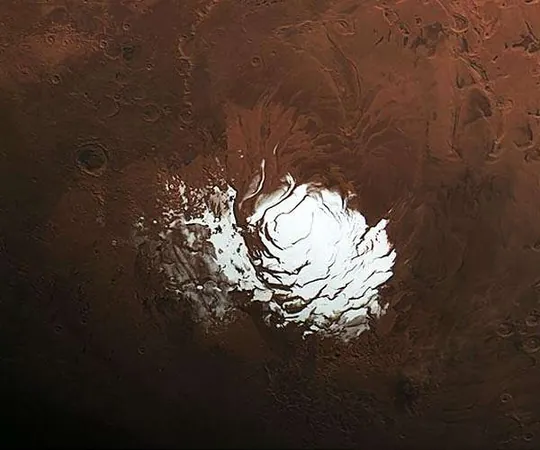
Ancient Martian Waterways: New Discoveries Unveil Secrets Beneath Icy Caps
2024-11-02
Author: Arjun
Introduction
In a groundbreaking study conducted by the Planetary Science Institute, researchers have unveiled intriguing evidence suggesting that ancient Mars was once home to a complex network of lakes and rivers, hidden beneath thick layers of ice. These findings not only provide valuable insights into the Martian hydrosphere some 3.6 billion years ago but also challenge previous assumptions about the planet’s climate and water flow.
Research Insights
The research, spearheaded by Peter Buhler, reveals that carbon dioxide, which has long been trapped within the Martian regolith, played a crucial role in creating conditions that facilitated substantial water movement on the Red Planet. As carbon dioxide froze over massive ice sheets at the poles, it insulated Mars’ surface, enabling the retention of heat and allowing water to flow even in a cooler climate.
New Model Explained
Buhler’s compelling model, published in the Journal of Geophysical Research: Planets, suggests that the interaction between carbon dioxide and the regolith is more influential than previously understood. 'The atmosphere plays a minor role,' Buhler stated, 'as the significant action occurs in the exchanges of carbon dioxide between the regolith and the southern polar ice cap, influenced by shifts in the planet's tilt over millennia.' This innovative perspective reshapes our comprehension of Mars’ carbon cycle.
Formation of Subglacial Rivers
As conditions fluctuated, carbon dioxide would gradually release from the regolith, accumulating atop the ice caps to act as insulation. This process eventually led to the melting of ice at the base, and the flowing meltwater did not seep deep into the crust; instead, it froze into permafrost along the sides of the ice sheet. The result was the formation of subglacial rivers, which carved out distinct landforms known as eskers—gravel ridges that serve as physical evidence of this past hydrological activity.
Implications for Mars' Climate
Buhler explains, 'The presence of eskers on Mars indicates that there was, at some point, subglacial melt. This raises questions about how we understand Mars’ ancient climate, as previous hypotheses often linked these melts to unspecified global warming events.' His model, however, provides a fresh explanation that does not rely on climate warming, suggesting that water flow was maintained through natural geological processes.
Hydrology and Potential for Life
As these subglacial rivers emerged from the ice sheets, they formed slow-moving streams, eventually filling basins like the Argyre Basin, which could have harbored a lake as expansive as the Mediterranean. Over millions of years, this lake would have overflowed, leading to significant water cycles that transported liquid water from the poles towards the equator.
Future Research
Buhler believes that ongoing tests of his model could prompt a major reevaluation of Mars' ancient hydrology and its potential for past life. Furthermore, there’s a possibility that once this meltwater traveled downstream, it may have sublimated back into the atmosphere, perpetuating a continuous water cycle crucial to sustaining conditions on early Mars.
Conclusion
The implications of these findings could reshape our understanding of not just Mars, but the potential for habitable environments beyond Earth. As scientists continue to explore these ancient Martian waterways, the search for signs of life continues to inspire both curiosity and wonder about our neighboring planet's history.


 Brasil (PT)
Brasil (PT)
 Canada (EN)
Canada (EN)
 Chile (ES)
Chile (ES)
 España (ES)
España (ES)
 France (FR)
France (FR)
 Hong Kong (EN)
Hong Kong (EN)
 Italia (IT)
Italia (IT)
 日本 (JA)
日本 (JA)
 Magyarország (HU)
Magyarország (HU)
 Norge (NO)
Norge (NO)
 Polska (PL)
Polska (PL)
 Schweiz (DE)
Schweiz (DE)
 Singapore (EN)
Singapore (EN)
 Sverige (SV)
Sverige (SV)
 Suomi (FI)
Suomi (FI)
 Türkiye (TR)
Türkiye (TR)